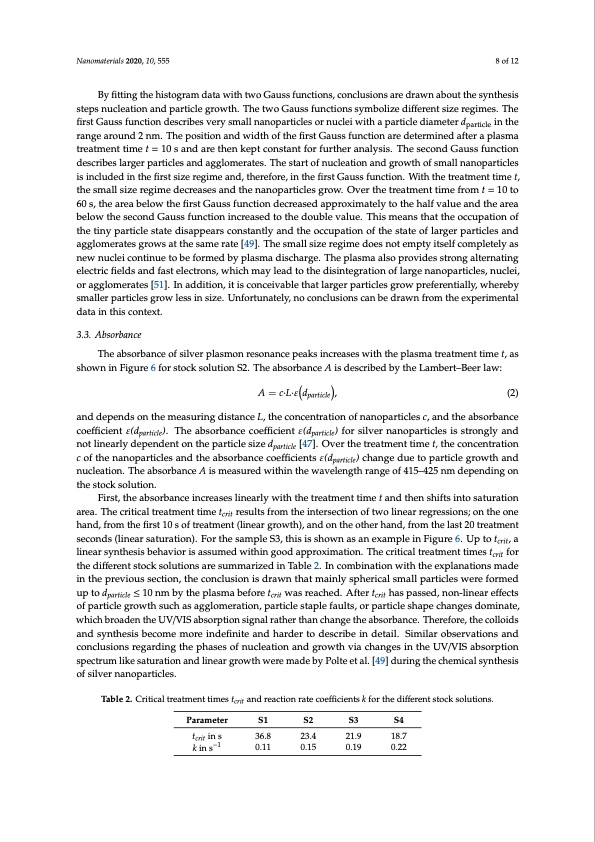
PDF Publication Title:
Text from PDF Page: 008
Nanomaterials 2020, 10, 555 8 of 12 By fitting the histogram data with two Gauss functions, conclusions are drawn about the synthesis steps nucleation and particle growth. The two Gauss functions symbolize different size regimes. The first Gauss function describes very small nanoparticles or nuclei with a particle diameter dparticle in the range around 2 nm. The position and width of the first Gauss function are determined after a plasma treatment time t = 10 s and are then kept constant for further analysis. The second Gauss function describes larger particles and agglomerates. The start of nucleation and growth of small nanoparticles is included in the first size regime and, therefore, in the first Gauss function. With the treatment time t, the small size regime decreases and the nanoparticles grow. Over the treatment time from t = 10 to 60 s, the area below the first Gauss function decreased approximately to the half value and the area below the second Gauss function increased to the double value. This means that the occupation of the tiny particle state disappears constantly and the occupation of the state of larger particles and agglomerates grows at the same rate [49]. The small size regime does not empty itself completely as new nuclei continue to be formed by plasma discharge. The plasma also provides strong alternating electric fields and fast electrons, which may lead to the disintegration of large nanoparticles, nuclei, or agglomerates [51]. In addition, it is conceivable that larger particles grow preferentially, whereby smaller particles grow less in size. Unfortunately, no conclusions can be drawn from the experimental data in this context. 3.3. Absorbance The absorbance of silver plasmon resonance peaks increases with the plasma treatment time t, as shown in Figure 6 for stock solution S2. The absorbance A is described by the Lambert–Beer law: A = c·L·εd , (2) and depends on the measuring distance L, the concentration of nanoparticles c, and the absorbance coefficient ε(dparticle). The absorbance coefficient ε(dparticle) for silver nanoparticles is strongly and not linearly dependent on the particle size dparticle [47]. Over the treatment time t, the concentration c of the nanoparticles and the absorbance coefficients ε(dparticle) change due to particle growth and nucleation. The absorbance A is measured within the wavelength range of 415–425 nm depending on the stock solution. First, the absorbance increases linearly with the treatment time t and then shifts into saturation area. The critical treatment time tcrit results from the intersection of two linear regressions; on the one hand, from the first 10 s of treatment (linear growth), and on the other hand, from the last 20 treatment seconds (linear saturation). For the sample S3, this is shown as an example in Figure 6. Up to tcrit, a linear synthesis behavior is assumed within good approximation. The critical treatment times tcrit for the different stock solutions are summarized in Table 2. In combination with the explanations made in the previous section, the conclusion is drawn that mainly spherical small particles were formed up to dparticle ≤ 10 nm by the plasma before tcrit was reached. After tcrit has passed, non-linear effects of particle growth such as agglomeration, particle staple faults, or particle shape changes dominate, which broaden the UV/VIS absorption signal rather than change the absorbance. Therefore, the colloids and synthesis become more indefinite and harder to describe in detail. Similar observations and conclusions regarding the phases of nucleation and growth via changes in the UV/VIS absorption spectrum like saturation and linear growth were made by Polte et al. [49] during the chemical synthesis of silver nanoparticles. Table 2. Critical treatment times tcrit and reaction rate coefficients k for the different stock solutions. particle Parameter tcrit in s k in s−1 S1 S2 S3 S4 36.8 23.4 21.9 18.7 0.11 0.15 0.19 0.22PDF Image | Formation Kinematics of Plasma-Generated Silver Nanoparticles

PDF Search Title:
Formation Kinematics of Plasma-Generated Silver NanoparticlesOriginal File Name Searched:
nanomaterials-10-00555-v2.pdfDIY PDF Search: Google It | Yahoo | Bing
Turbine and System Plans CAD CAM: Special for this month, any plans are $10,000 for complete Cad/Cam blueprints. License is for one build. Try before you buy a production license. More Info
Waste Heat Power Technology: Organic Rankine Cycle uses waste heat to make electricity, shaft horsepower and cooling. More Info
All Turbine and System Products: Infinity Turbine ORD systems, turbine generator sets, build plans and more to use your waste heat from 30C to 100C. More Info
CO2 Phase Change Demonstrator: CO2 goes supercritical at 30 C. This is a experimental platform which you can use to demonstrate phase change with low heat. Includes integration area for small CO2 turbine, static generator, and more. This can also be used for a GTL Gas to Liquids experimental platform. More Info
Introducing the Infinity Turbine Products Infinity Turbine develops and builds systems for making power from waste heat. It also is working on innovative strategies for storing, making, and deploying energy. More Info
Need Strategy? Use our Consulting and analyst services Infinity Turbine LLC is pleased to announce its consulting and analyst services. We have worked in the renewable energy industry as a researcher, developing sales and markets, along with may inventions and innovations. More Info
Made in USA with Global Energy Millennial Web Engine These pages were made with the Global Energy Web PDF Engine using Filemaker (Claris) software.
Infinity Turbine Developing Spinning Disc Reactor SDR or Spinning Disc Reactors reduce processing time for liquid production of Silver Nanoparticles.
| CONTACT TEL: 608-238-6001 Email: greg@infinityturbine.com | RSS | AMP |